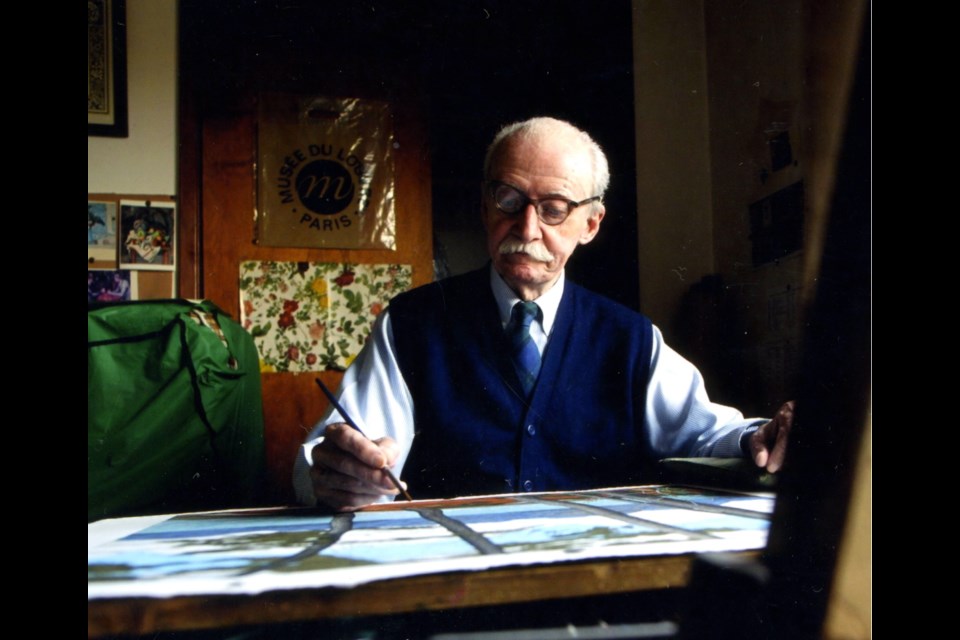“One of the main reasons I paint is because I think nature’s so wonderful that I want to try to get my feeling down about that on canvas if possible. I feel that when I am doing my painting, it is a form of worship.”
— E.J. Hughes, speaking on The Lively Arts, a CBC television production in 1961.
 Of all the artists of British Columbia, Emily Carr undoubtedly takes top place. And after her comes E.J. Hughes (1913-2007).
Of all the artists of British Columbia, Emily Carr undoubtedly takes top place. And after her comes E.J. Hughes (1913-2007).
You might not know Hughes, but he’s strongly represented at the National Gallery, and his paintings are a constant feature of art auctions, selling for as much as $1.6 million. Hughes was born in North Vancouver, grew up in Nanaimo, and lived most of his long life at Shawnigan Lake and Duncan.
During his career, Hughes avoided public life. His work required such concentration that if the telephone rang he would be unable to continue painting for the rest of the afternoon. He was known as a sort of recluse, was rarely interviewed and avoided offering opinions.
Hughes was an early graduate of the Vancouver School of Art, studying there from 1928 to 1935. Following that, he became the first Canadian “war artist” in the Second World War, creating more than 1,600 works now in the Canadian War Museum. In 1947, Lawren Harris awarded him the Emily Carr Scholarship, which Hughes used for a sketching trip between Victoria and Courtenay. Most of the resulting paintings were in his studio when, in 1951, Hughes received a visit from Max Stern.
Stern owned the Dominion Gallery in Montreal, recognized as the top gallery in Canada. His gallery represented Harris, and from him he heard about an artist on the West Coast.
As he explained it: “In 1943 I went west in search of new Canadian artists and found Emily Carr. In 1951, I went west again and found Ed Hughes, and since then, I have found no other.”
Stern went on: “The meeting proved to be fascinating: There was a shy painter who was not at all aware of the unusual quality of his work, an artist who was not really convinced of his own talent. So — as I had done seven years earlier in the case of Emily Carr, whose representative and agent I became — I decided on the spot to take Hughes under my wing.”
From then on, the Dominion Gallery bought everything Hughes produced. Through Stern’s shrewd management, Hughes was able to avoid becoming a public figure. He had shows at many prestigious museums, but never attended an opening.
He was able to spend his life painting the waterfront along the Cowichan Valley, and not many people there know much about his work. He was perhaps best known for eating his lunch at the Dog House restaurant in Duncan.
As a painter myself, I found his example inspiring. He chose local subjects, based his compositions on skilful drawing, and resolved his paintings with the focus of a Zen monk. Hughes lived a life of great restraint, and thus I was surprised, one day in 1993, to receive a phone call from his assistant, Patricia Salmon.
She said Hughes knew about me from my writing in the newspaper, and wanted to thank me for my encouragement. Hughes was coming to Victoria, for his car’s annual service, and would like to take my wife and me for lunch. Surprised and delighted, we joined them at the Snug at the Oak Bay Beach Hotel.
Far from being a hermit, Hughes was only too happy to answer questions and tell us stories about his life. To help the conversation along, Salmon brought a paper bag full of snapshots, as well as some drawings by Hughes and a couple of his etchings. We covered the table with this material and sorted through it over the next two hours. In the end, she left me with a good portion of the photographs, and they became the beginnings of my archive of things relating to E.J. Hughes.
There was much about this man — his upright posture, his tweed jacket and tie, and his patient and attentive demeanour — that made a visit with him seem like visiting someone for whom time had stopped in the 1930s. Out of gratitude, I wrote a note of thanks to the elderly gentleman, and over the next few years, my wife and I received a number of handwritten and carefully composed letters from the artist.
I didn’t want to presume upon the basis of our meeting to take things further, so I was pleased to receive another invitation, in 1996, for my wife and me to have lunch with Hughes. He and Salmon met us in Duncan and took us to his home, to see his studio.
We then spent the afternoon together visiting the sites he had been painting at Maple Bay and Bird’s Eye Cove. To sit beside the artist in the back seat of his Jaguar, while he directed us to some of his favourite sketching sites, was an experience I had never imagined would take place. Sharing these moments with Hughes has been a high point of my career.
You can see Hughes’ paintings at Whistler in the new Audain Museum. Both the University of Victoria and the Art Gallery of Greater Victoria own outstanding examples of his work. A portion of his 1938 mural is on permanent display in the Port of Nanaimo Centre. The E.J. Hughes Gallery at 28 Station St. in Duncan carries prints of his work, and the Shawnigan Museum has a Hughes exhibit.
Hughes is on my mind for, at the moment, I am completing a book titled E.J. Hughes Paints Vancouver Island. The book will be published by TouchWood Editions of Victoria this spring.
